Introduction
In April 2020, Hola! USA magazine asked Ivy Queen, known as “La Reina del Reggaetón,” to name a “possible successor, the next powerhouse of urbano music.” 1 The Boricua and OG reggaetonera responded:
I feel like all of them are like my daughters, regardless of whether they speak well of me or not. Like every mother, you have children that shine and others that are a bit more rebellious, but you love them all the same. I can see myself in a lot of them – when they wear colorful wigs, long nails with intricate art – it reminds me that I’ve made my mark. For example, Rosalía, who I was speaking to recently, seems like a breath of fresh air. Despite her not being a Latina, her flow and her singing ability is something that you can tell she puts her heart into, and I love that…Apart from her look and her voice, I have a high appreciation of her lyrics and if I were only to look at that aspect of her music, Rosalía would be my candidate as successor. What Rosalía possesses is something that you are born with, adding to that natural ability is the fact that she grew up listening to songs from Lola Flores as well as being raised with the proper tools at home much like me…I also see myself in her flow and her passion for singing. 2
Media 1: Custic, Filip. “new ‘proyecto’ for the goddess @rosalia.vt: cover for ‘EL MAL QUERER’ (practicing ‘sfumato virtual’).” Instagram, September 14, 2018. Accessed September 2, 2022.
And so, La Rosalía, the Spanish megastar behind the 2018 hit album El Mal Querer (EMQ) (see media 1), is poised to be pop urbano music’s next “Queen.” 3
Urbano, an umbrella category that includes a number of musical styles and genres, including reggaetón, Latin hip-hop, Latin trap, and dembow, encompasses Spanish-language “urban” music, defined by the use of rhythms brought from Africa in the colonial period and developed by Black diasporic populations in the Caribbean in the 1990s. Mainland US audiences got their first taste in 2004 with Daddy Yankee’s reggaetón classic, “Gasolina,” but it was not until Luis Fonsi’s 2017 pop reggaetón megahit “Despacito,” made in collaboration with Daddy Yankee and later remixed by Justin Bieber, that urbano established itself within the mainstream (that is, English-speakers in the United States) market. While Fonsi and Yankee paved the way for artists like Bad Bunny to gain popularity in the US while singing exclusively in Spanish, they also accelerated the pop-ification of urbano music, as well as its whitening. 4
Reggaetón, for example, grew out of poor, predominantly Black neighborhoods in Puerto Rico. However, as Petra Rivera-Rideau and other scholars have explained, the genre has undergone a significant shift as it has become more broadly accepted, including “pop musical aesthetics as opposed to the more percussive and less melodious hip-hop and dancehall sounds of the 1990s, as well as the elevation of artists who embody the so-called “Latin look,” featuring tan skin, straight or wavy dark hair, and European features.” 5 The phenomenon of whitening, or blanqueamiento, is not unique to reggaetón, occurring in every corner of “Latin” entertainment. 6 The same ingrained racism within Latin American and US Latinx communities is similarly wont to elevating Spanish artists, who are lazily and conveniently lumped together with American artists by the music industry. 7 In many ways then, it is no surprise that the same industry threw its weight behind Rosalía as soon as she dropped “Con altura” (2019), her pop urbano collaboration with Colombian reggaetonero J Balvin.
This essay proposes that the stage was set for Rosalía to become Ivy Queen’s choice as successor the year before, in the flamenco-inspired EMQ. Through an examination of the music videos and promotional art of EMQ, I will argue that Rosalía’s mobilization of Marian imagery served to de-emphasize the singer’s whiteness and Spanish-ness, thereby priming her to be a golden child of the US mainstream music industry. The cult of the Virgin pervades the cultures of Latin America and its diasporic populations due to the evangelization that fueled Iberian colonial projects. Thus, while EMQ‘s references to the Virgin reflect the singer’s Spanish identity, when viewed in light of the album’s other references to Latin American cultures, Rosalía’s self-presentation, and her subsequent collaborations, they are also the tools of an artist poised to benefit from colonially-instituted cultural similarities. By placing EMQ‘s Marian imagery in dialog with art from colonial Latin America, works by Chicana artists, and contemporary ploys to attract the “Latin” market, this essay will demonstrate how Rosalía’s Marian references can be understood as an extension of the colonial propaganda through which the Virgin first infiltrated the Americas around 1500. As we shall see, Rosalía’s newfound royalty is not just part of a systemic problem of whitewashing Afro-Latin musical forms, but also the result of the activation of visual discourses of colonial violence.
Andalucía as Colonial Nexus
Fittingly, Rosalía’s American invasion began in the same place that Spain’s did in the early modern period: Andalucía. 8 The Catalana’s tie to the region comes through flamenco, a musical artform from Andalucía closely associated with its Romani population, the Calé. Rosalía studied under the tutelage of Gaditano artist El Chiqui de la Línea and EMQ is an adaptation of the thesis she produced at Barcelona’s Taller de Músics. 9 In addition to using flamenco music, the album’s music videos also make heavy use of bullfighting imagery, which has decreased in popularity on a national level due to animal rights concerns but is still associated with southern Spain. That Rosalía wore a stylized matador costume in her brief cameo in Cardi B’s “WAP” (2020) video, emphasizes how much the Catalana has used the culture of Andalucía as her personal brand.
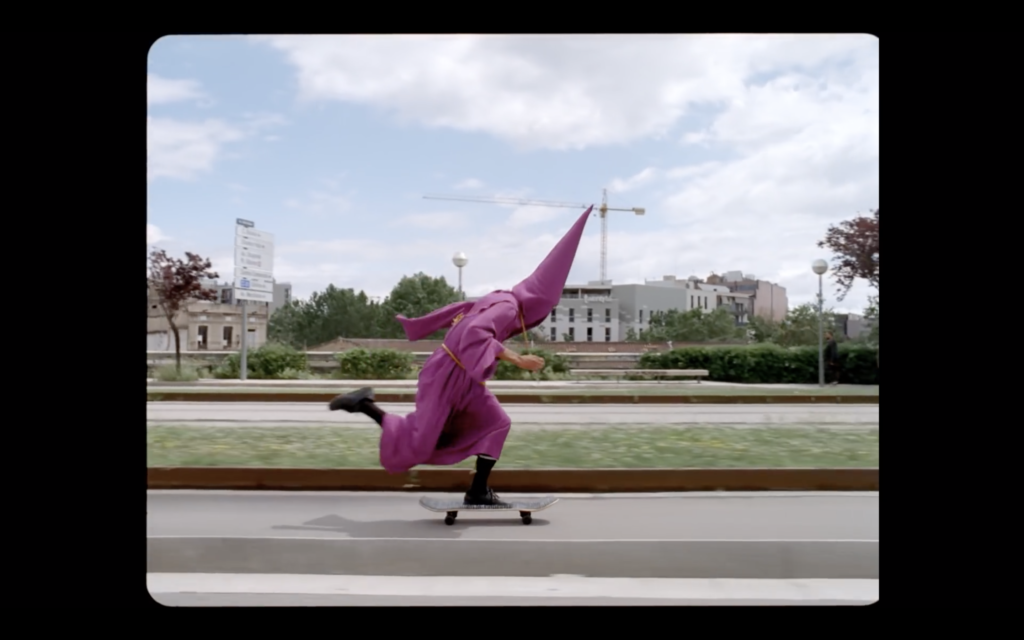
The visual thread that pulls EMQ together, however, is the region’s religious visual culture. Andalucía, especially its capital Sevilla is known for the elaborate Semana Santa (Holy Week) processions that its penitential confraternities popularized during the Spanish “Golden Age.” 10 During the annual celebrations, as well as on other occasions in the liturgical calendar, confraternity members, called “nazarenos,” process sculpted images of Christ and the Virgin through the streets of the city, reenacting the Passion. The hooded nazareno makes an appearance only in the video for “Malamente” (see figure 1), but Marian imagery appears throughout EMQ, making reference to the images that are integral to Sevilla’s religious, cultural, and social fabric. Rosalía made EMQ‘s Sevillian allusions explicit in an unreleased song called “De madrugá,” inspired by the processions that take place on the night of Holy Thursday. 11 Sung from the point of view of the nazarenos and the images of the Virgin, the song is a testament to the dynamic, living qualities attributed to the wood-carved actors of Semana Santa and to Sevilla’s devotional intensity.
In the early modern period, Sevilla was the only authorized port of embarkation for the Americas. As a result, the city and its region exerted disproportionate cultural and religious influence upon the Spanish viceroyalties there. 12 The lasting effect of this influence is evident for example, in the tradition of processing religious images in Cusco, Peru, for the feast of Corpus Christi. Andalucía’s particular brand of devotion to the Virgin is one of its most significant and longstanding cultural exports.
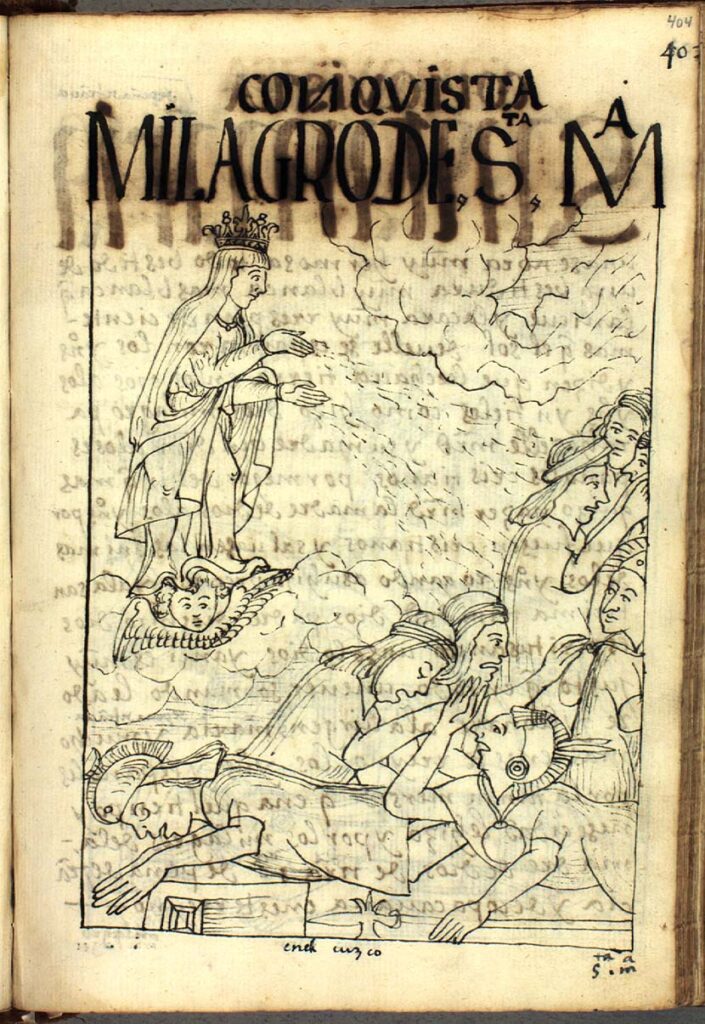
The Virgin was no mere tool in the Spanish invasion of the Americas, but rather one of its key players. Christopher Columbus’s devotion was so fervent that Marian imagery pervaded his infamous voyage for the “Indies.” 13 Hernán Cortés set off for Mexico supplied with a bevy of images of the Virgin, intended for distribution. According to the sixteenth-century chronicler Bernal Díaz del Castillo, Columbus installed a Marian statue, along with a cross, in a temple in Cozumel as a symbol of Spanish presence, in plain defiance of the pleas of its Native people. 14 In the Andes, the Virgin is said to have come to the aid of the Spanish forces led by Francisco Pizarro in their battle against the Inka. The Inka chronicler Felipe Guaman Poma de Ayala depicted the gentle violence of the Virgin in one of these apparitions in Cusco, in which she appears throwing sand and dirt into the Indigenous soldiers’ eyes, causing them to fall before her (see figure 2).
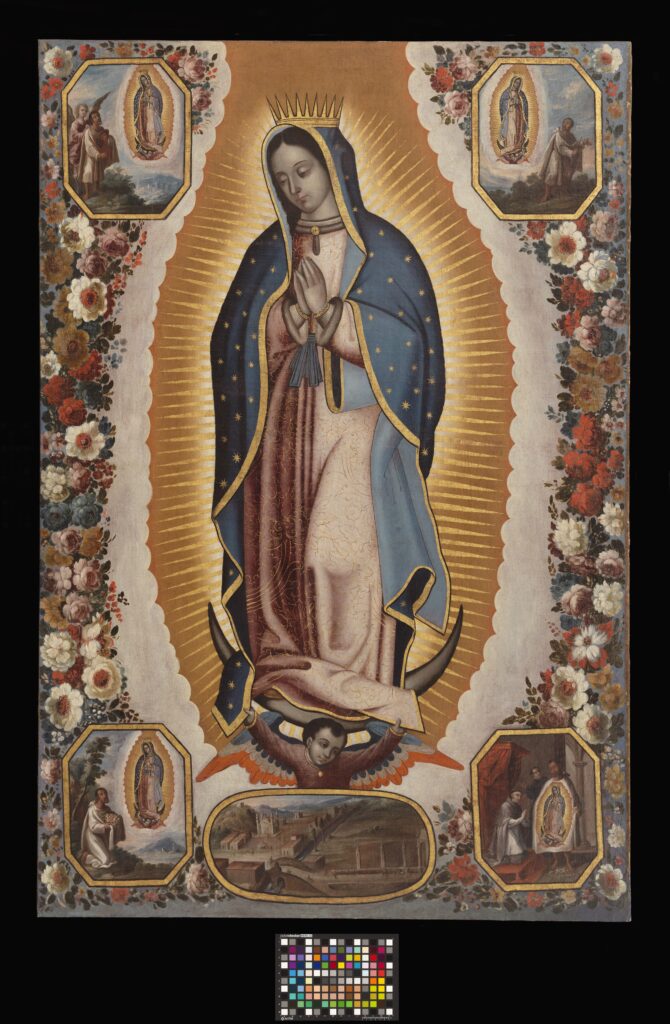
After the initial battles of the Invasion era, the religious orders in the Spanish Americas were successful in using the Virgin for the evangelization work that was the apparent justification for the colonial venture. Their spiritual arsenal included producing and taking advantage of connections between the Mother of Christ and the feminine sacred prior to 1500. Perhaps most famously, in sixteenth-century New Spain, the Virgin of Guadalupe (see figure 3) is believed to have miraculously appeared on the tilma (a piece of Nahua clothing) of the Chichimeca man Juan Diego Cuauhtlatoatzin. According to Catholic belief, the Guadalupana not only spoke to him in his native Nahuatl but did so from the hill of Tepeyac that was associated with the earth deity Tonantzin. Similarly, in the Viceroyalty of Peru, the Virgin was likened to Pachamama, as the earth was known to the Inka, which remains central to Andean cosmologies.
Well after Spain was officially ousted from the Americas in the nineteenth-century, the Marian images introduced in the colonial period remained and were reborn as emblems for Latin American countries. Just as Mexico has the Virgen de Guadalupe, Bolivia has the Virgen de Copacabana, Cuba has the Virgen de la Caridad del Cobre, the Dominican Republic has the Virgen de la Altagracia, and so on. Though initially imposed by colonialism, each of these images of the Virgin acquired associations with divinities native to the Americas and Africa (and sometimes both) that helped transform Spanish Marian artworks into culturally potent entities that continue to play important roles in the religious and secular lives of their respective countries. These ties are so critical that those living in diaspora in the United States, even after multiple generations, maintain their Marian affinities, irrespective of the strength of their Catholic faith. 15 Virgins are so pervasive among US Latinxs that some devotions have come to operate as a shorthand for certain populations, as in the case of the Guadalupana and Chicanxs. Paradoxically, formerly colonized people have managed to transform a figure that remains closely associated with their colonizers into a vehicle for self-definition and celebration. In short, La Virgen has helped Latin Americans and US Latinxs supersede the confines of Catholicism and colonialism, making it all the more bitter that she has also helped position Rosalía to edge out local urbano musicians.
La Diosalía
Media 2: Martins, Juliana. “Inmaculado corazón de Rosalía.” Instagram, June 1, 2019. Accessed September 2, 2022. https://www.instagram.com/p/ByK3yZcFTGH/.
EMQ makes its Marian intentions clear from the outset and her fans have clearly made the connection (see media 2). 16 On the album’s cover (see media 1), a nude Rosalía emerges triumphantly from the heavens like a sexualized Virgin of the Immaculate Conception.
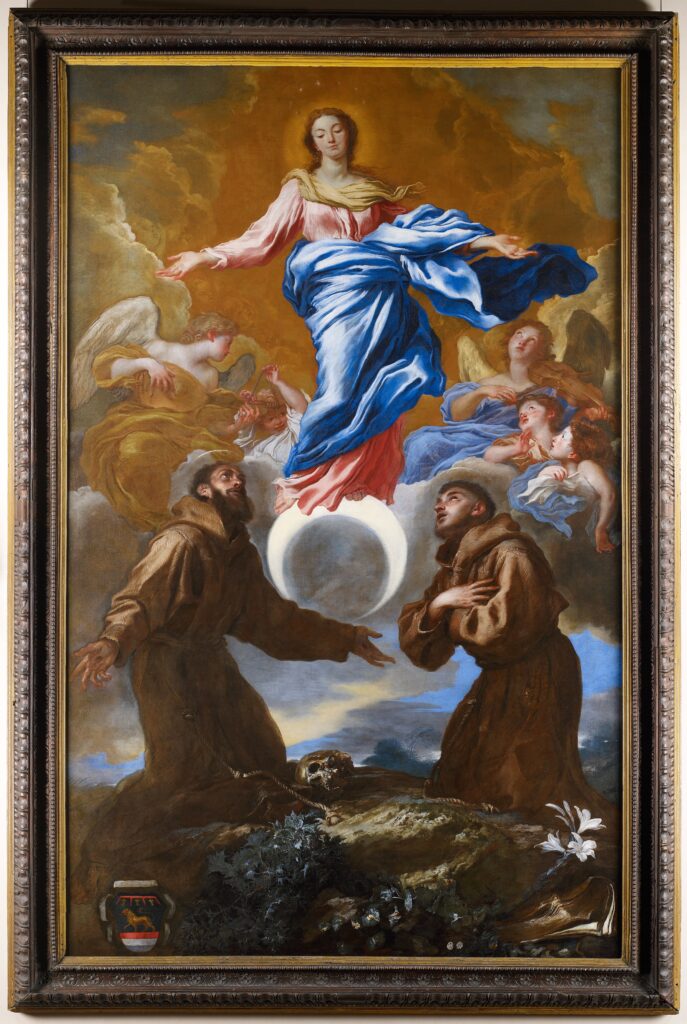
144 x 105 3/4 in. (365.76 x 268.61 cm) framed. Minneapolis Institute of Art, purchase through the Putnam Dana McMillan Fund, 66.39 (Photo: MIA)
The Inmaculada, a title that refers to Mary’s birth without original sin, was a very popular devotion in early modern Spain and subsequently in Spanish America as well. 17 Its iconography, which includes a halo of stars, a crescent moon, and an aura of light, was even developed by the Sevillian artist Francisco Pacheco (1564-1644) based on the figure of the Woman of the Apocalypse in Revelation. On the cover of EMQ, Rosalía has a halo of seven stars around her head and, although she is not standing on a moon, the bottom edge of her white mantle is very reminiscent of one. Her pose, which has also been likened to the crucified Christ’s outstretched arms, has at times been used for the Inmaculada (see figure 4). To be sure, these art historical references are not by coincidence – the allusion to Francisco Goya’s The Dressed Maja (1800-1805) in the video for “Di mi nombre” shows how well-versed Rosalía, or at least her team, is in European art history.
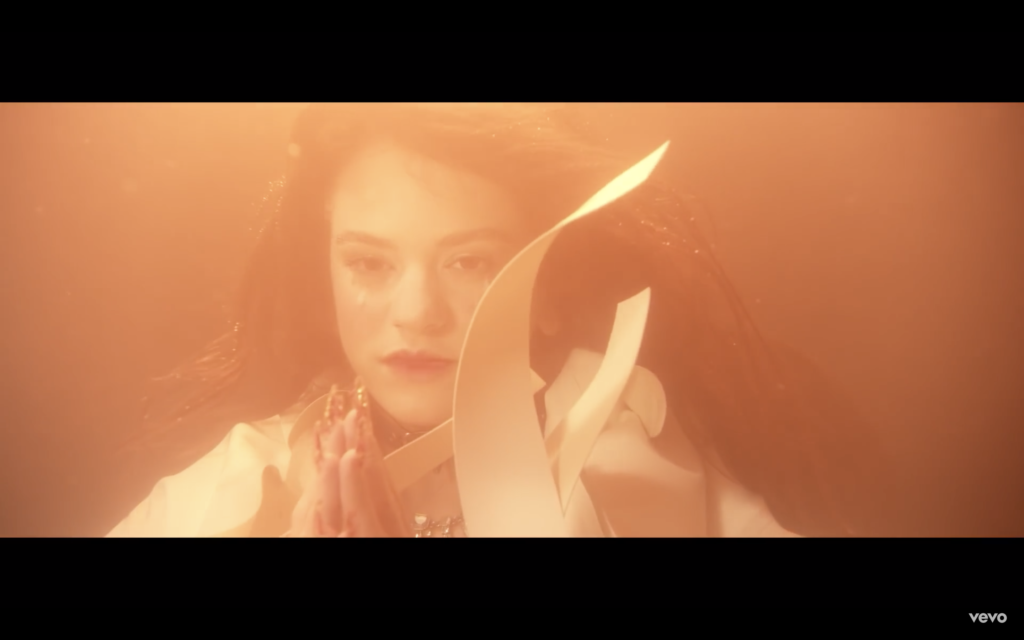

The video for “Bagdad” (see figure 5), the most overtly religious song on the album, takes up and develops the cover’s imagery further, in the unlikely context of the notorious live-sex club in Barcelona after which the song is named. Rosalía begins the song as a Bagdad performer who retreats to the bathroom and proceeds to drown in her own tears. She is reborn in the deluge wearing a flowing white dress, with her hands in prayer, and ascending toward a glowing golden light above her. This bears a strong resemblance to paintings by Bartolomé Murillo and his circle of the Virgin of the Immaculate Conception (see figure 6), even sharing similar background colors. Notably, the imagery also resonates with the Virgin of Guadalupe (see figure 3), another Inmaculada who holds her hands in the same position.
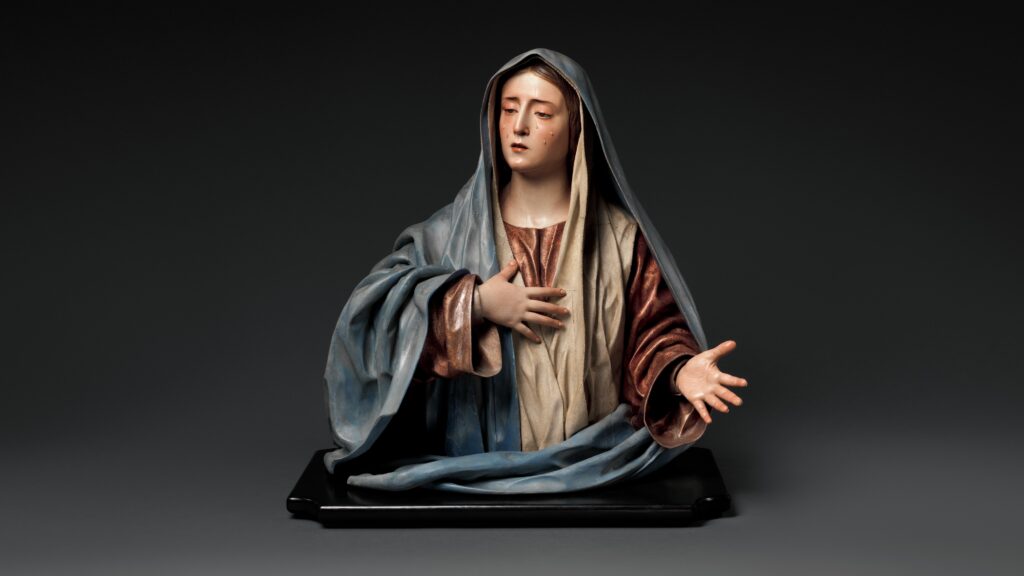
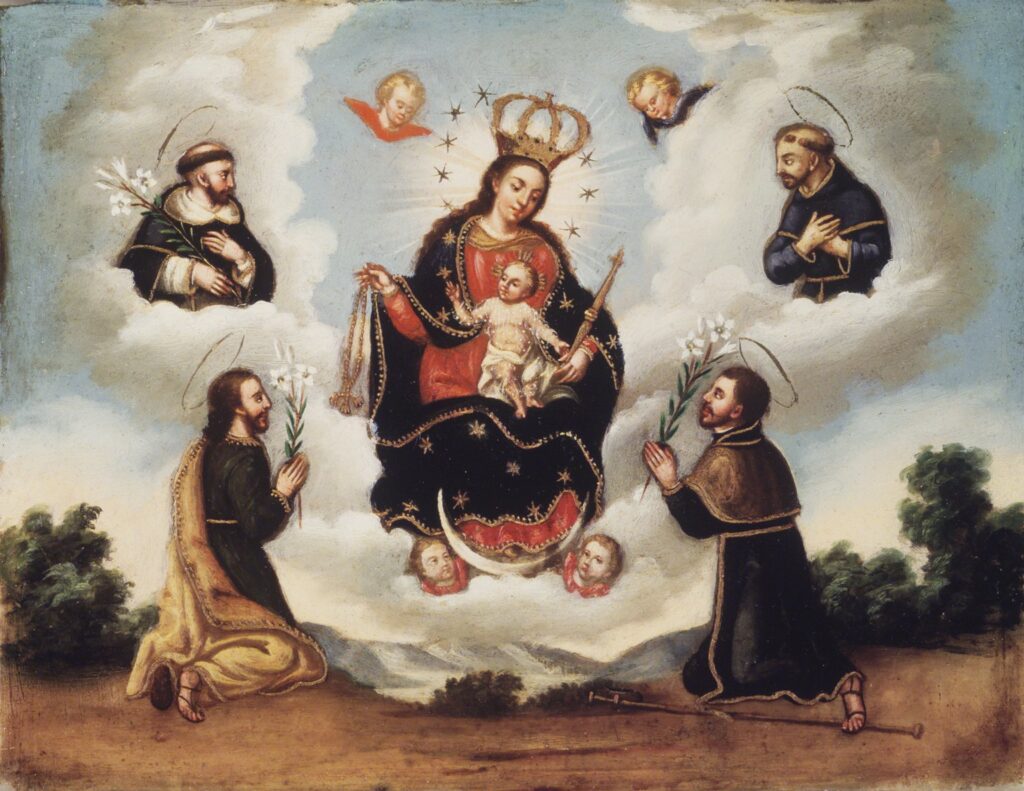
Whereas the cover and “Bagdad” appropriate elements of Marian iconography, the still image for “Reniego” (see media 3) seemingly instructs its viewers to worship “La Diosalía” as they would the Virgin. The singer’s face fills a triangle in the center that appears to be cut into the empty space around her. The intermittent teardrops that run down her cheeks suggest she is a Dolorosa (see figure 7), a title of the Virgin named for the sorrow Mary experienced after the death of Christ. From each of the frame’s four corners, disembodied, white hands make offerings to the heroine. Most significantly, in the bottom-right corner two sets of hands are held together as if in prayer with rosaries, beads that aid Catholics in the recitation of a set of prayers that form part of Marian devotion. Admittedly, this is a clever play on the Catalana’s name, but the message here is clear: Rosalía, like the Virgin, deserves our worship. And while the lesson may have originally been directed toward Spanish viewers, it once again applies just as well in Latin America, where colonial painted images instructed viewers that the rosary was a gift from the Virgin herself (see figure 8).
Dressing Like A Virgin
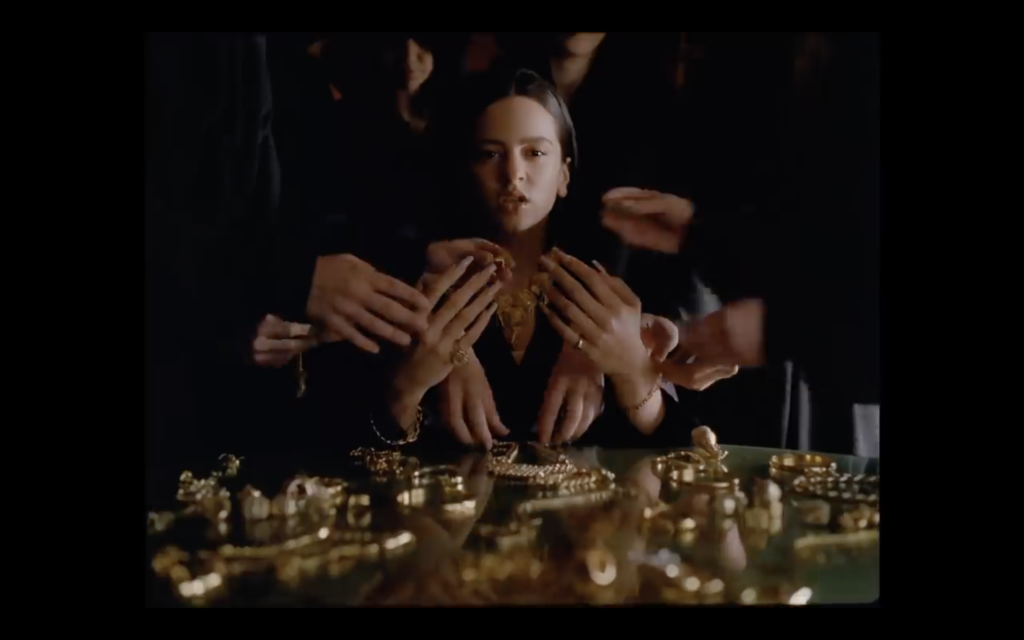
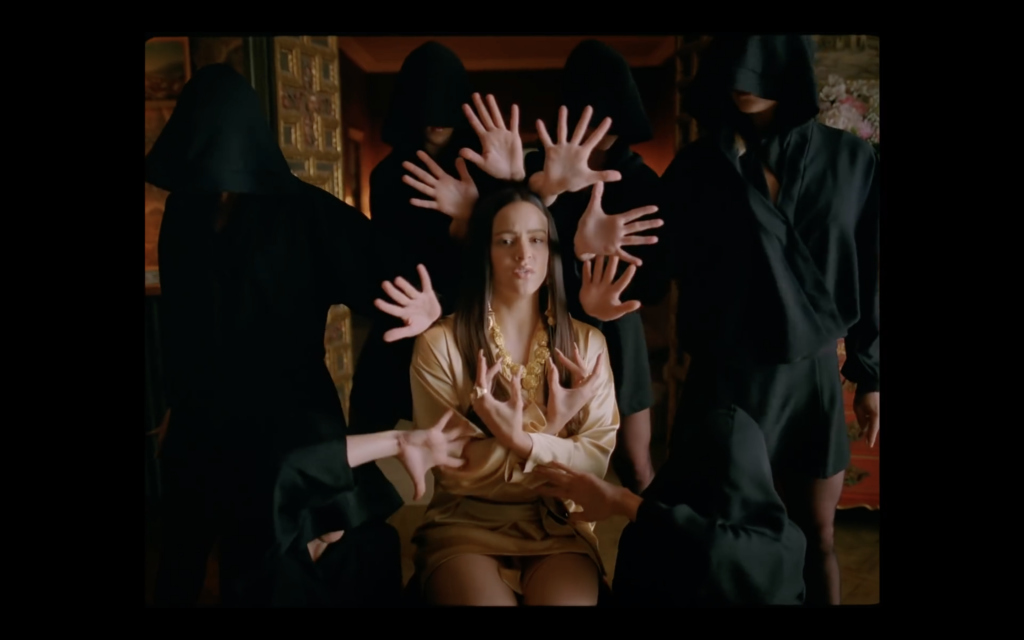

Arguably more problematic than likening herself to the Virgin is Rosalía’s co-option of the sacred images and traditions of ritual dressing that have been an important part of Spanish devotional practices since the medieval period. This can be seen most clearly in the “Pienso en tu mirá” video, in which attendants in matching black robes carefully adorn Rosalía with large pieces of golden jewelry (see figure 9). Moreover, once the attendants finish adorning the singer, they arrange their hands around her in a manner suggestive at once of the golden lobed crown that surrounds the Virgen del Roció in Huelva, Spain, the niches in which altar statues are placed, and the aura of light that often surrounds the Virgin in painted depictions (see figure 10). While the video’s sequence could be understood as the dressing of a secular royal figure, the headboard on the bed in the video resembles an altar decorated with a crown (see figure 11), strongly implying that Rosalía is not just any queen, but specifically the Queen of Heaven, another of the Virgin’s many titles.
It should be stressed that with these references the singer was certainly alluding to Sevilla’s carved and polychromed wooden sculptures of the Virgin, which are opulently adorned by devotees with clothing and jewelry, as well as wigs of human hair, glass eyes, and glass tears. 18 The Spanish brought such images and traditions to the Americas in the colonial period and, as art historian Maya Stanfield-Mazzi has argued in the case of the Andes, they played a critical role in the evangelization process, in part because of the tangible nature of ritual adornment. 19
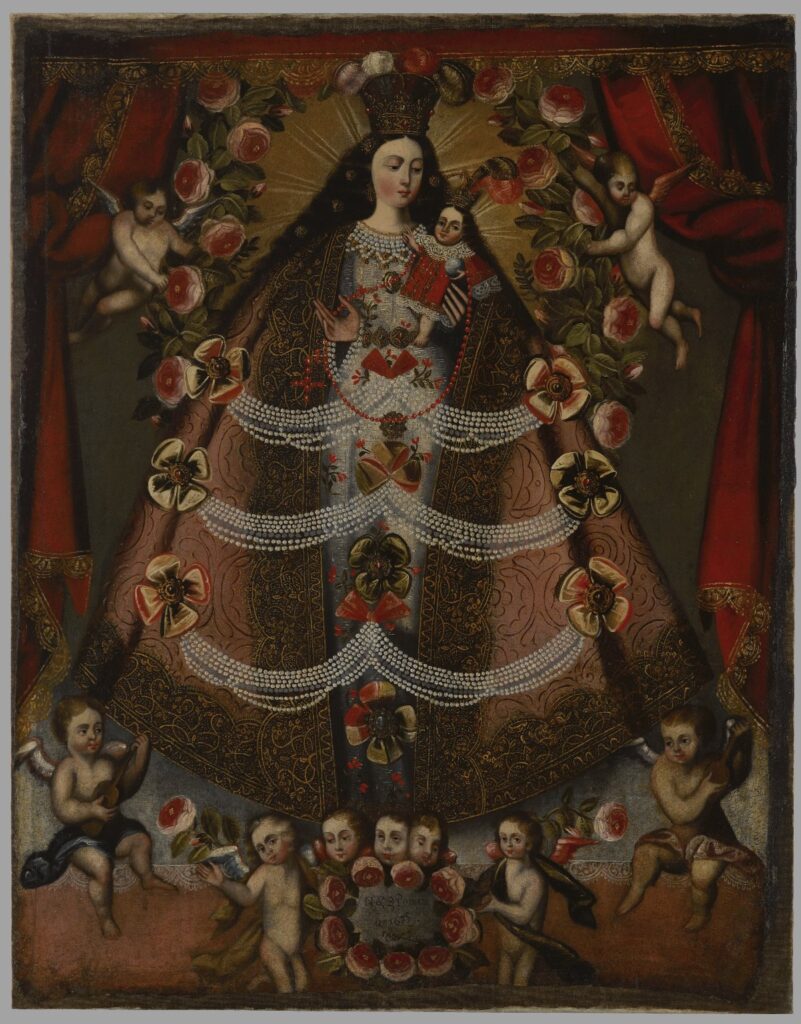
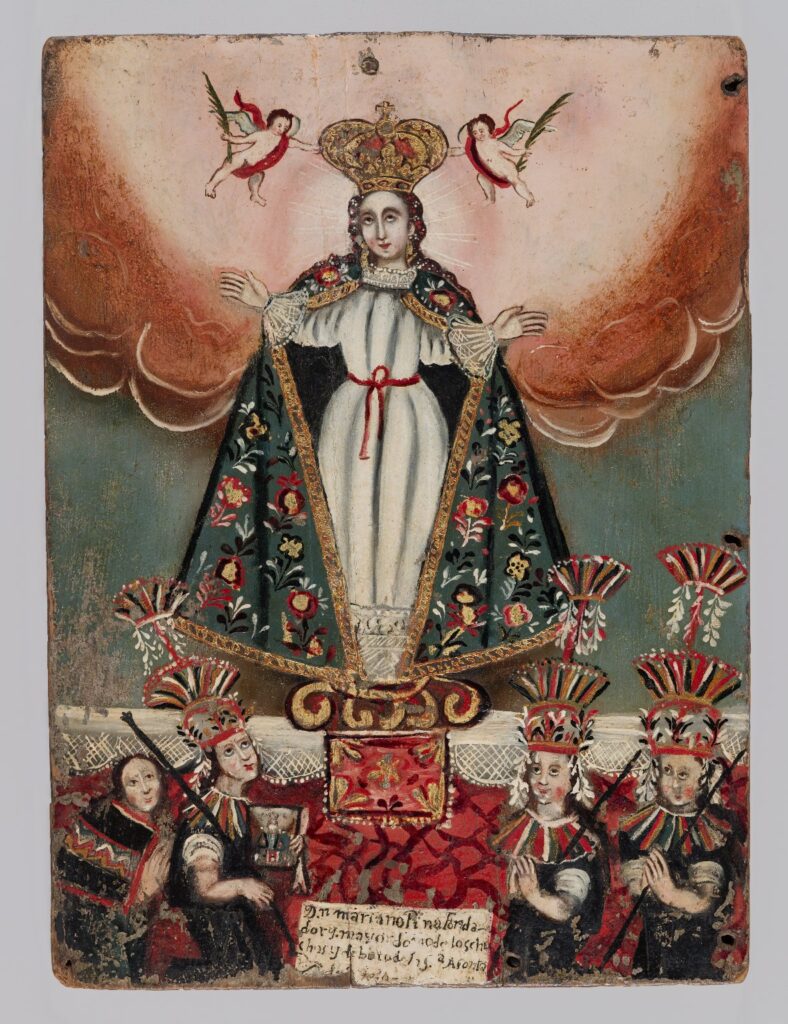
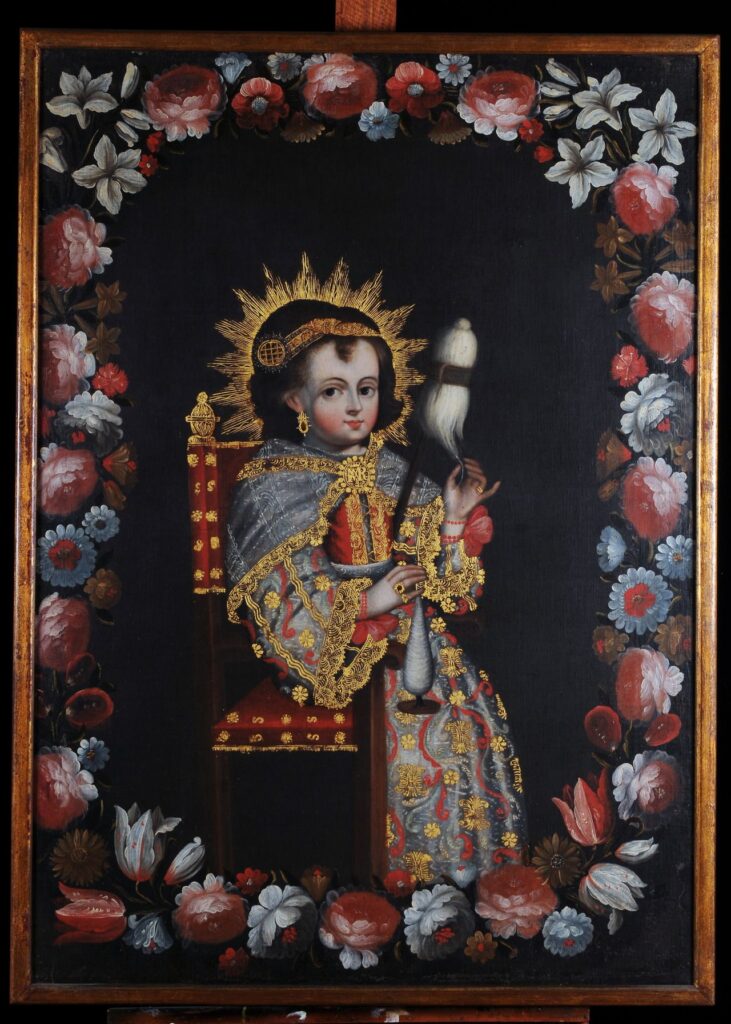
The success of these artworks is evidenced by the prevalence in the Andes of statue paintings (see figure 12), which depicted popular sacred images standing on their decorated altars. While statue paintings depicted real sculptures and adornments, they often also included fictive elements that served to exalt the image, but also blurred certain boundaries of colonial reality. In The Virgin Mary with Indigenous (Aymara) Donors (see figure 13), for example, the pigments used for the Virgin’s face make the sculpture appear alive, straddling the line between object and living figure. 20 Interestingly, the same paint is used for the Indigenous devotees at her feet, making them look as pale skinned as their Virgin. Conversely, in Virgen niña hilando (1760, see figure 14), the Virgin is Andeanized, not through skin color, but through her vestments. A famous seventeenth-century statue painting goes one step further, depicting an image of the Christ Child dressed in the accoutrements of Inka royalty and with the brown skin of an Indigenous Andean. These examples bear witness to the role that colonial religious visual culture played within the fluid nature of race in colonial Spanish America and point to how Rosalía’s self-fashioning after the Virgin helped her traverse the racial and ethnic lines of Latinidad into the pop urbano throne.
Tattooed Devotion
Rosalía’s manipulation of the Virgin operates in tandem with the symbolic power the Virgin continues to wield in Spain. Early in the video for “Malamente,” the Catalana trades her Marian mantle for that of a devotee when she wipes the torso of a young torero-in-training who bears a tattoo of the face of a weeping Virgin. Consistent with EMQ‘s Andaluz theme, the Virgin depicted is the Virgen de la Macarena, an iconic Sevillian Virgin that is processed during Semana Santa. 21 The scene has sparked significant conversation, with some praising it as a good example of how to bring Spain’s “old,” “traditional” Catholic culture into the twenty-first-century, and others criticizing it for reinforcing stereotypical female gender roles in the Iberian peninsula. 22
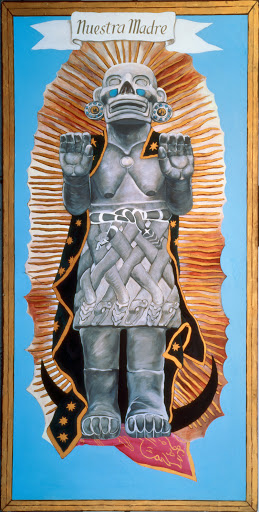
At the same time, for Chicanx viewers the tattoo calls to mind a culture of Virgen tattoos that serve as both signs of devotion and spaces of dissent. Tattoos of the Guadalupana were initially adopted by men, many of whom were incarcerated, for protection and as a sign of Chicano masculinity. 23 The Texas-based Chicana artist Delilah Montoya explored this phenomenon in her series Guadalupe en Piel (2000), concluding that a Virgin tattoo is “a ritual act meant to provide protection against harm and also empowers the inmate during conflict by wearing ‘Our Lady.’ In following the myth, the tattooed inmate can be thought of as a symbolic Xipe Totec who is the male aspect of Tonantzin and, by wearing the Guadalupe, he empowers himself with both the male and female energies.” 24 By referencing the pre-Invasion Mexica past, tattoos of a figure introduced by the Spanish are rendered decolonial by Montoya. Yolanda López made this explicit in Nuestra Madre (1981-88, see figure 15) by merging the Virgin of Guadalupe with the earth monster Coatlicue, a Mexica deity named for her skirt of snakes.
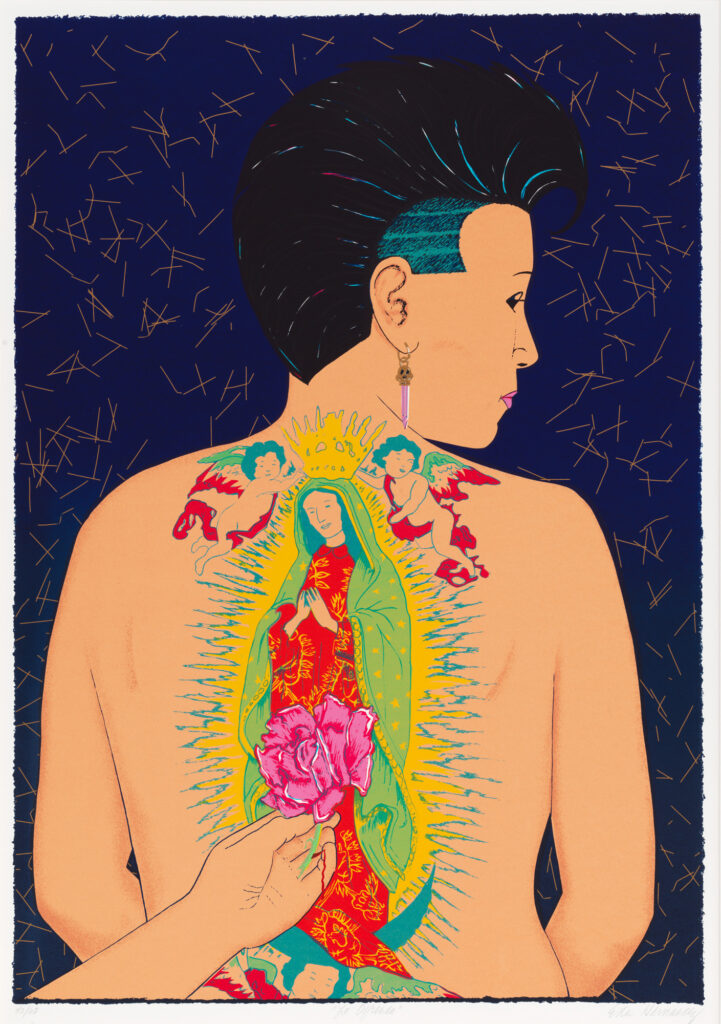
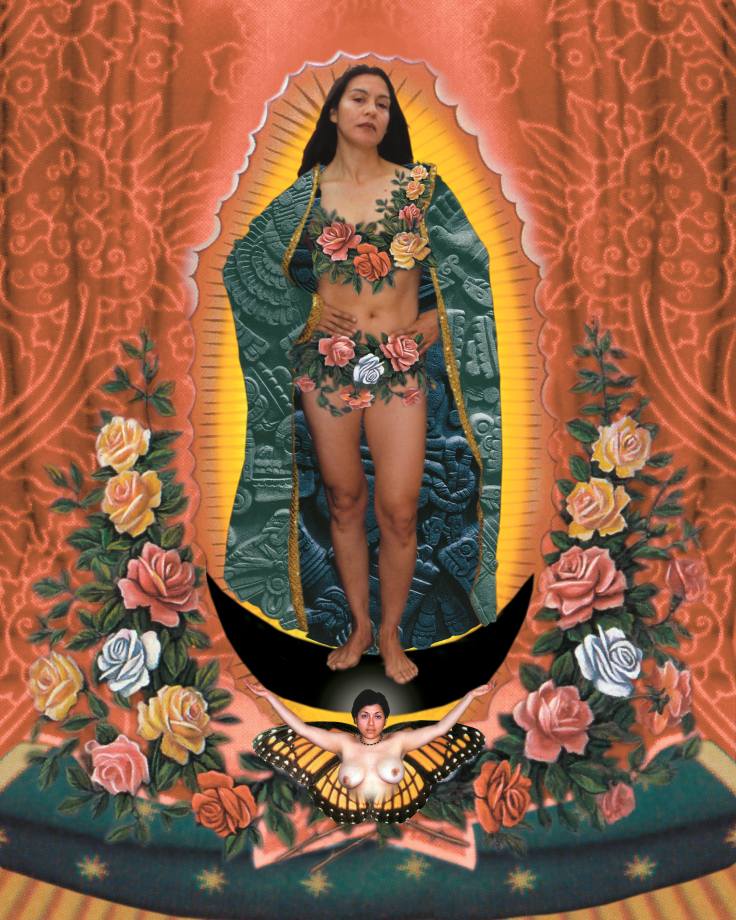
Queer Chicana artists, too, have mobilized Guadalupe tattoos, as anti-colonial tools through which to subvert the Spanish expectations of femininity and heteronormativity imposed upon Indigenous peoples in the colonial period. In the print La Ofrenda (1988, see figure 16), for example, Esther Hernández “likened lesbian desire to divine love” by placing a Virgin tattoo on the bared back of a masculine-presenting Chicana. 25 Her print opened the way for Alma López to transform a Brown lesbian into a Virgin in her controversial digital collage, Our Lady (1999, see figure 17), as an assertion of queer Chicana empowerment. 26 Images like Alma López’s “devil in a rose bikini” urge us to reconsider EMQ‘s album cover and Rosalía’s use of La Virgen as a re-colonization and re-whitening of a figure that Latinxs have works so hard to Indigenize toward decolonial ends.
“Something Cool To Incorporate Into Her Costume”
Lest we imagine that the visual connections EMQ makes between Spain and Latin America are mere coincidence, the image that accompanies “Que no salga la luna” (see media 4) indicates Rosalía was knowingly appealing to Latin American and US Latinx viewers. By inserting herself into Frida Kahlo’s The Two Fridas (1939), Rosalía mobilizes Hispanidad to make a claim that she exists seamlessly on both sides of the Atlantic. 27 While Spanish is spoken in both Spain and Mexico, the elision of the two is problematic, as it conflates colonizer with colonized. The Catalana’s penchant for invoking Kahlo, which she took up again in the video for “A Palé” (2019), is perversely appropriate: Frida, despite her appreciation for the Indigenous cultures of Mexico and being of Zapotec descent, was not herself Tehuana and was open about the performative nature of her Tehuana dress: “I have never been in Tehuantepec, nor has Diego [Rivera] ever wanted to take me, nor do I have any relationship with that people, but of all Mexican dresses it is the one I like the most, and that is why I dress like a Tehuana.” 28 Just as Frida put on Tehuana dress to please Diego, so can we understand that Rosalía has put on Kahlo dress to appeal to Mexican audiences.
Furthermore, we must consider the singer’s visual choices in light of the fact that her entire career has been colored by the appropriation of marginalized people for personal gain. Rosalía’s ascent to superstardom was made possible by adopting the costume of the Calé, the Romani peoples in Iberia, whom the Spanish call Gitanos, through flamenco. 29 Before it became part of Spanish national identity under the cash-strapped Franco regime, flamenco was reviled in the peninsula as vulgar, precisely because of its association with the Calé (much in the same way reggaetón was once criminalized prior to its adoption as a national symbol of Puerto Rico). 30 Noelia Cortés, a prominent Gitana activist has complained that Rosalía “uses Gitanos like something cool to incorporate into her costume, but socially speaking, we do not matter to her.” 31 Parallels are easily drawn here with the Catalana’s appropriation of urbano aesthetics. While Rosalía has not abandoned her use of flamenco symbols, she is now often found sporting long nails, hoop earrings, and chunky gold jewelry, signaling that she has put on a new costume.
Media 6: Knowles, Beyoncé. “We would like to share our love and happiness…”. Instagram, February 1, 2017. Accessed September 2, 2022.
The song “Nana” is the result of this double appropriation. “Nana” takes lyrics from two lullabies known to be popular among Calé mothers, “A la puerta del Cielo” and “Duérmete niño chico.” Its image (see media 5) uses the shoes from the prior lullaby to locate the cosmic setting as Heaven and connect a nude, heavily pregnant Rosalía with the expectant Virgin. 32 The image further alludes to Mary through the singer’s pose, which is a direct reference to one of Beyoncé’s viral 2017 pregnancy announcement photos (see media 6) that borrowed heavily from imagery of the Virgin, especially the Guadalupana. 33 Regarding the artistic allusions, Jim Nikas, the director of the Posada Art Foundation, speculated that Queen Bey “created a lot of this imagery to appeal to a Latin American market.” 34 While both artists engaged in problematic practices of cultural appropriation, it should be noted that, in the same year, Beyoncé agreed to do a remix of J Balvin and Willy Williams’s hit single “Mi Gente” and donated all her proceeds to Latin American countries in need. 35 In referencing Beyoncé’s birth announcement then, the Spanish singer built on previous capitalistic efforts to use the Virgin to profit from the “Latin” market and become their “queen,” except Rosalía has not even bothered to perform concern for the descendants of the people whom her ancestors conquered. 36
Conclusion
The success of EMQ was soon followed by “Con altura,” a pop urbano hit initially composed by the Catalán duo of Pablo Díaz-Reixa (also known as El Guincho) and Rosalía. With its hypnotic melody and dembow beat, the song quickly rose on the charts, both Spanish and English, winning “Best Urban Song” at the 2019 Latin Grammys (the same year EMQ won several awards, including “Album of the Year”). The selection prompted media outlets to dub Rosalía a “Latina” megastar that brought fresh accusations of cultural appropriation. In response to these criticisms, Rosalía has asserted that her “sampling” is acceptable in a world in which “all cultures are connected” and “musical barriers, like genres, are so diluted that they don’t really exist.” 37 At the same time, she seems aware that she is taking from cultures distinct from her own, habitually reminding critics of her Cuban great-grandfather and that “flamenco cantes de ida y vuelta” prove how “flamenco and [her] country always have been connected with Latin America.” 38 What Rosalía somehow fails to recognize, however, is that this connection was forged through the horrors of invasion, genocide, and slavery.
Much in the same way that Spaniards forced colonial subalterns in the Americas to accept La Virgen, the mainstream music industry has now asked their descendants to embrace La Rosalía. The singer’s use of Marian imagery was critical to this process and its success is made plain by the mainstream music industry’s eagerness to elevate her to the pop urbano throne. Her success has come at the cost of artists like Sech, an Afro-Panamanian rising star in urbano music. His song, “Otro Trago” (2019) hit No. 1 on Billboard’s Hot Latin Music charts, yet its press did not compare with that of “Con Altura,” which came out the same year. Discussing reggaetón, but easily applied to all urbano music, Chikki, an Afro-Dominican photographer, artist, and musician lamented: “It’s good that it is reaching globally, and that it’s touching people from all backgrounds. But at the same time, it’s neglecting the people that actually started it.” 39
In truth, Rosalía’s manipulation of Marian imagery is quite apt. Like the Virgin – the Queen of Heaven who helped to invade the lands and very identities of the peoples of the Americas – Rosalía crossed the Atlantic and reinforced Spanish hegemony. By recognizing this, we are forced to consider the long-lasting influence of colonial visual culture and the danger, as Audre Lorde warned, of using “the master’s tools.” That is to say, the cultural creations of Latin America and its diasporic populations, like the Marian images discussed above and urbano music, are the generative results of colonialism, but their connections to the colonizer leave them vulnerable for exploitation.
Works Cited:
“‘La Reina Del Reggaetón’ Ivy Queen Reveals How She Sees Herself in Spanish Singer Rosalía.” Hola! USA, April 16, 2020, https://us.hola.com/celebrities/20200204fkcyjayv77/ivy-queen-talks-about-rosalia
“Así se modernizan siete tópicos (viejos y nuevos) españoles,” El País, May 30, 2018, https://elpais.com/elpais/2018/05/30/icon/1527691092_555624.html.
“Malamente, el vídeo de Rosalía que turba y desconcierta.” El Mundo, July 20, 2018, https://www.elmundo.es/cultura/musica/2018/05/30/5b0e7ac346163f160f8b463b.html;
“Rosalía: La mejor Frida Khalo [sp],” Vida Latina, 2019, https://vidalatina.com/http-vidalatina-com-35214-2/.
Bambi, “Frida Dice Lo Que Sabe,” Excelsior, June 15, 1954.
Benzal Alía, María Guadalupe. “Análisis intercultural del álbum musical de Rosalía Vila, El Mal Querer y el consecuente rechazo de la comunidad gitana española.” BA thesis, Universidad Pontificia Comillas, 2019.
Butler, Bethonie. “Reggaeton Needed a Racial Reckoning. Afro-Latinos Are Leading It.” The Washington Post, November 23, 2020, https://www.washingtonpost.com/arts-entertainment/2020/11/23/reggaeton-afro-latin-grammys/.
Cepeda, Eduardo. “How Bad Bunny Took Over Pop – Singing Exclusively in Spanish.” February 16, 2019, https://www.billboard.com/articles/news/latin/8498239/bad-bunny-billboard-cover-story-%202019.
Cobo, Leila. “Why Everybody’s Betting Big on Rosalía, the Flamenco Star No One Saw Coming.” Billboard, October 10, 2019, https://www.billboard.com/articles/columns/latin/8532527/rosalia-billboard-cover-story-interview-2019.
Gallagher, Brian. “Rosalia Makes a Pledge towards Equality While Accepting Her Rising Star Award at the Billboard Women in Music Awards.” Daily Mail Online, December 13, 2019, https://www.dailymail.co.uk/tvshowbiz/article-7788367/Rosalia-makes-pledge-equality-accepting-Rising-Star-Award.html.
Garcia, Maira, Sandra E. Garcia, Isabelia Herrera, Concepción de León, Maya Phillips, and A.O. Scott., “‘In the Heights’ and Colorism: What Is Lost When Afro-Latinos Are Erased.” The New York Times, June 21, 2021, https://www.nytimes.com/2021/06/21/movies/in-the-heights-colorism.html.
Gaspar de Alba, Alicia and Alma López, eds., Our Lady of Controversy: Alma Lopez’s “Irreverent Apparition.” Austin: University of Texas Press, 2012.
Gonzales, Erica. “You Totally Missed Blue Ivy Singing on Beyoncé’s ‘Mi Gente’ Remix.” Harper’s Bazaar, September 29, 2017, https://www.harpersbazaar.com/culture/art-books-music/a12655727/blue-ivy-singing-beyonce-mi-gente/.
Hall, Linda B. “Discoverers, Conquerors, and Mary,” in Mary, Mother and Warrior: The Virgin in Spain and the Americas. Austin: University of Texas Press, 2004.
Holguín, Sandie. Flamenco Nation: The Construction of Spanish National Identity (Madison: University of Wisconsin Press, 2019).
Latorre, Guisela. “Icons of Love and Devotion: Alma López’s Art.” Feminist Studies 34, no. 1/2 (2008): 148.
Lee, Bertram T., Juan Bromley, and Sophy E. Schofield, eds., Libro de los cabildos de Lima (Lima: Imp. Torres Aguirre, Sanmartí y Cía., 1935), 38-39.
Macarena, Hermandad de la. “Historia de las mariquillas de la Esperanza Macarena.” Tienda de la Hermandad de la Macarena (blog), 2015, https://www.hermandaddelamacarena.es/tienda/blog/12_historia-mariquillas-esperanza-macarena.html.
Marchese, Kieron. “Digital Artist Filip Custic Dissects the Human Body in Surrealist 3D Sculptures.” Designboom, January 7, 2020, https://www.designboom.com/art/interview-filip-custic-human-body-surrealist-3d-sculptures-01-07-2020/.
Montoya, Delilah. “Guadalupe En Piel Artist Statement.” 2000, http://www.delilahmontoya.com/ArtistStatement.html#Guadalupe.
Piñero, Álvaro. “The Ultimate Guide to Understanding Rosalía’s References.” I-D, July 30, 2019, https://i-d.vice.com/en_uk/article/9kx47y/the-ultimate-guide-to-understanding-rosalias-references.
Red Bull Music, How Reggaeton Is Empowering Women, 2018, https://www.youtube.com/watch?v=KMOpc9xQr_I.
Reina, Elena. “Rosalía, a la conquista de América.” El País, November 28, 2018, https://elpais.com/cultura/2018/11/28/actualidad/1543435190_189662.html.
Rivera-Rideau, Petra and Jericko Torres-Leschnik, “The Colors and Flavors of My Puerto Rico: Mapping ‘Despacito”s Crossovers.” Journal of Popular Music Studies 31, no. 1 (2019): 92.
Sebastián, Víctor. “Filip Custic, el artista al que Rosalía conoció por Instagram y le pidió que diseñara la portada de ‘El mal querer.'” WATmag, November 14, 2018, https://www.thewatmag.com/quien-es/filip-custic-artista-al-que-rosalia-conocio-instagram-le-pidio-que-disenara-portada-mal-querer.
Stanfield-Mazzi, Maya. Object and Apparition: Envisioning the Christian Divine in the Colonial Andes. University of Arizona Press, 2013.
Storey, Kate. “The Secret Meaning Behind Beyoncé’s Pregnancy Photo Shoot.” Harper’s Bazaar, February 2, 2017, https://www.harpersbazaar.com/culture/news/a20368/beyonce-pregnancy-photo-symbolism-decoded/.
Úbeda Rodríguez, Lara. “Enciclopedia Rosalía: cómo comprender (del todo) el significado de sus canciones.” Los 40, July 23, 2019, https://los40.com/los40/2019/07/22/musica/1563795517_174164.html.
Ugarte, Rubén Vargas. Historia del culto de Maria en Ibero-América y de sus imágenes y santuarios más celebrados. Madrid: Talleres Gráficos Jura, 1956.
Valdes, Marcela. “Rosalía’s Incredible Journey From Flamenco to Megastardom.” The New York Times, October 18, 2019, https://www.nytimes.com/interactive/2019/10/08/magazine/rosalia-flamenco.html.
Varo, Alejandro. “Mu malamente hecho, Rosalía.” nuevatribuna.es, July 30, 2018, https://www.nuevatribuna.es/articulo/cultura—ocio/mu-malamente-hecho-rosalia/20180730162211154399.html.
Webster, Susan V. Art and Ritual in Golden-Age Spain: Sevillian Confraternities and the Processional Sculpture of Holy Week. Princeton: Princeton University Press, 1998.
- “‘La Reina Del Reggaetón’ Ivy Queen Reveals How She Sees Herself in Spanish Singer Rosalía,” Hola! USA, April 16, 2020, https://us.hola.com/celebrities/20200204fkcyjayv77/ivy-queen-talks-about-rosalia.[↑]
- “‘La Reina Del Reggaetón’ Ivy Queen Reveals How She Sees Herself in Spanish Singer Rosalía.” It should be noted that Ivy Queen’s choice is likely influenced by a personal dispute involving urbano artist Anuel AA, the boyfriend of popular reggaetonera Karol G, who put down Ivy Queen in an effort to elevate his girlfriend to the throne.[↑]
- Rosalía is from outside Barcelona, in Catalunya. Catalunya’s relationship to Spain – existing as either a separate country or an autonomous community of Spain – is complex and contested. For the purposes of this essay, I will refer to Rosalía as both Catalán and Spanish since she identifies as both and because she is consistently identified as “Spanish” by the media.[↑]
- Eduardo Cepeda, “How Bad Bunny Took Over Pop – Singing Exclusively in Spanish,” February 16, 2019, https://www.billboard.com/articles/news/latin/8498239/bad-bunny-billboard-cover-story-%202019. J Balvin, the so-called “Prince of Reggaetón” and Karol G, who vies for Ivy Queen’s title, are not of African descent and have been criticized for their tone-deaf responses to the murder of George Floyd at the hands of Minneapolis police on May 25, 2020. Bethonie Butler, “Reggaeton Needed a Racial Reckoning. Afro-Latinos Are Leading It,” The Washington Post, November 23, 2020, https://www.washingtonpost.com/arts-entertainment/2020/11/23/reggaeton-afro-latin-grammys/.[↑]
- Petra Rivera-Rideau and Jericko Torres-Leschnik, “The Colors and Flavors of My Puerto Rico: Mapping ‘Despacito”s Crossovers,” Journal of Popular Music Studies 31, no. 1 (2019): 92.[↑]
- Most recently, Lin-Manuel Miranda’s recent film, “In the Heights” (2021), faced criticism for a lack of dark skinned actors, despite being set in a predominantly Afro-Dominican neighborhood. Maira Garcia et al., “‘In the Heights’ and Colorism: What Is Lost When Afro-Latinos Are Erased,” The New York Times, June 21, 2021, https://www.nytimes.com/2021/06/21/movies/in-the-heights-colorism.html.[↑]
- See, for example, Enrique Iglesias and Alejandro Sanz.[↑]
- Elena Reina, “Rosalía, a la conquista de América,” El País, November 28, 2018, https://elpais.com/cultura/2018/11/28/actualidad/1543435190_189662.html.[↑]
- Marcela Valdes, “Rosalía’s Incredible Journey From Flamenco to Megastardom,” The New York Times, October 18, 2019, https://www.nytimes.com/interactive/2019/10/08/magazine/rosalia-flamenco.html.[↑]
- Susan V. Webster, Art and Ritual in Golden-Age Spain: Sevillian Confraternities and the Processional Sculpture of Holy Week (Princeton: Princeton University Press, 1998), 5.[↑]
- Beginning at midnight, the confraternities of El Silencio, La Macarena, La Esperanza de Triana, El Gran Poder, and El Calvario – wearing costumes like that of the skateboarding nazareno – bring their statues of Christ and the Virgin out on procession.[↑]
- Lima, for example, actively modeled its religious visual culture after Seville’s. On 8 June 1550, the city council ordered that its municipal officials must process closest to the host, because officials “normally [do so] in Spain, in Seville,” and that failing to follow the order was punishable by “grave penalties and incarceration.” Bertram T. Lee, Juan Bromley, and Sophy E. Schofield, eds., Libro de los cabildos de Lima (Lima: Imp. Torres Aguirre, Sanmartí y Cía., 1935), 38-39.[↑]
- For instance, the flagship of the voyage was the Santa María, and the departure date (3 August 1492) was purposefully scheduled for the day following the feast of the Virgen de los Ángeles in the Franciscan monastery of La Rábida in the Spanish province of Huelva. Columbus credited the Virgin for saving the Niña from destruction in a heavy storm on the journey. He also named several islands in the Caribbean after different advocations of the Virgin. Linda B. Hall, “Discoverers, Conquerors, and Mary,” in Mary, Mother and Warrior: The Virgin in Spain and the Americas (Austin: University of Texas Press, 2004), 45–80.[↑]
- Hall.[↑]
- See, for example, the results for searching “Virgen” on the Latinx media website, Mitú. https://wearemitu.com/search/virgen/.[↑]
- The music videos were directed by CANADA (Malamente), Henry Schofield (Di mi nombre), and Helmi (Bagdad). The album’s artwork was created by Spanish-Croatian digital artist Filip Ćustić, who describes his work as a combination of surrealism and objetismo, a term he coined to convey his exploration of the relationship between the human body and the object. Víctor Sebastián, “Filip Custic, el artista al que Rosalía conoció por Instagram y le pidió que diseñara la portada de ‘El mal querer,'” WATmag, November 14, 2018, https://www.thewatmag.com/quien-es/filip-custic-artista-al-que-rosalia-conocio-instagram-le-pidio-que-disenara-portada-mal-querer. His objetismo depends on the use of “universal symbols,” such as religious imagery, that “humans can understand and interpret” and form “puzzles of information.” Kieron Marchese, “Digital Artist Filip Custic Dissects the Human Body in Surrealist 3D Sculptures,” Designboom, January 7, 2020, https://www.designboom.com/art/interview-filip-custic-human-body-surrealist-3d-sculptures-01-07-2020/.[↑]
- See: Rubén Vargas Ugarte, Historia del culto de Maria en Ibero-América y de sus imágenes y santuarios más celebrados (Madrid: Talleres Gráficos Jura, 1956).[↑]
- Webster, Art and Ritual in Golden-Age Spain.[↑]
- Maya Stanfield-Mazzi, Object and Apparition: Envisioning the Christian Divine in the Colonial Andes (University of Arizona Press, 2013).[↑]
- This is a common feature of the genre and it is not unique to colonial Peru. See, for example: Madonna of the Harpies (1517) by Andrea del Sarto.[↑]
- La Macarena is an anonymous seventeenth-century sculpture that has been attributed to the circle of the famous sculptor Pedro Roldán. La Macarena is associated with José Gómez Ortega, a celebrated Spanish bullfighter known as Joselito. It was he who gave the Virgin her signature green brooches and his funeral in 1920 was the only instance in which the Virgin wore black. It is this association that has made La Macarena especially potent for bullfighters. Hermandad de la Macarena, “Historia de las mariquillas de la Esperanza Macarena,” Tienda de la Hermandad de la Macarena (blog), 2015, https://www.hermandaddelamacarena.es/tienda/blog/12_historia-mariquillas-esperanza-macarena.html.[↑]
- “Malamente, el vídeo de Rosalía que turba y desconcierta,” El Mundo, July 20, 2018, https://www.elmundo.es/cultura/musica/2018/05/30/5b0e7ac346163f160f8b463b.html; “Así se modernizan siete tópicos (viejos y nuevos) españoles,” El País, May 30, 2018, https://elpais.com/elpais/2018/05/30/icon/1527691092_555624.html.[↑]
- Guisela Latorre, “Icons of Love and Devotion: Alma López’s Art,” Feminist Studies 34, no. 1/2 (2008): 148.[↑]
- Delilah Montoya, “Guadalupe En Piel Artist Statement,” 2000, http://www.delilahmontoya.com/ArtistStatement.html#Guadalupe.[↑]
- Latorre, “Icons of Love and Devotion,” 148.[↑]
- Latorre, 148. On Our Lady, see: Alicia Gaspar de Alba and Alma López, eds., Our Lady of Controversy: Alma Lopez’s “Irreverent Apparition” (Austin: University of Texas Press, 2012).[↑]
- “Rosalía: La mejor Frida Khalo [sp],” Vida Latina, 2019, https://vidalatina.com/http-vidalatina-com-35214-2/.[↑]
- “Nunca he estado en Tehuantepec, ni Diego me ha querido llevar nunca, ni tengo relación alguna con ese pueblo, pero de todos los vestidos mexicanos es el que más me gusta y por eso me visto de Tehuana.” Bambi, “Frida Dice Lo Que Sabe,” Excelsior, June 15, 1954.[↑]
- For example, she uses the word undivé (God) in “Malamente,” sacáis (eyes) in “Que no salga la luna,” and ducas (regrets, pains) in “Reniego.” These Caló words are not recognized by the Real Academia Española and, while they are used in flamenco and by the Calé, they have not been incorporated colloquially into Iberian Spanish. For a thorough list of EMQ‘s appropriation of Calé culture, see: María Guadalupe Benzal Alía, “Análisis intercultural del álbum musical de Rosalía Vila, El Mal Querer y el consecuente rechazo de la comunidad gitana española” (BA thesis, Universidad Pontificia Comillas, 2019).[↑]
- See: Sandie Holguín, Flamenco Nation: The Construction of Spanish National Identity (Madison: University of Wisconsin Press, 2019).[↑]
- “[Rosalía] usa a los gitanos como algo cool que incorporar a su disfraz, pero no le importamos socialmente hablando” Alejandro Varo, “Mu malamente hecho, Rosalía,” nuevatribuna.es, July 30, 2018, https://www.nuevatribuna.es/articulo/cultura—ocio/mu-malamente-hecho-rosalia/20180730162211154399.html.[↑]
- Lara Úbeda Rodríguez, “Enciclopedia Rosalía: cómo comprender (del todo) el significado de sus canciones,” Los 40, July 23, 2019, https://los40.com/los40/2019/07/22/musica/1563795517_174164.html. The song begins “a la puerta del cielo venden zapatos [at Heaven’s gate shoes are sold].”[↑]
- Rosalía clearly sees herself as being in conversation with Beyoncé. “Di mi nombre” and its first few lines are a reference to Destiny’s Child’s 1999 hit, “Say My Name.” Rosalía also referenced the closing of the Louvre for the filming of Beyoncé and Jay Z’s “Apeshit” (2018) in the song “Milionària.” Álvaro Piñero, “The Ultimate Guide to Understanding Rosalía’s References,” I-D, July 30, 2019, https://i-d.vice.com/en_uk/article/9kx47y/the-ultimate-guide-to-understanding-rosalias-references.[↑]
- Kate Storey, “The Secret Meaning Behind Beyoncé’s Pregnancy Photo Shoot,” Harper’s Bazaar, February 2, 2017, https://www.harpersbazaar.com/culture/news/a20368/beyonce-pregnancy-photo-symbolism-decoded/.[↑]
- Beyoncé donated her proceeds from the collaboration to Puerto Rico, Mexico, and other tragedy-stricken islands in the Caribbean. Erica Gonzales, “You Totally Missed Blue Ivy Singing on Beyoncé’s ‘Mi Gente’ Remix,” Harper’s Bazaar, September 29, 2017, https://www.harpersbazaar.com/culture/art-books-music/a12655727/blue-ivy-singing-beyonce-mi-gente/.[↑]
- Rosalía is no stranger to activism. Like many white feminists, she has spoken passionately about and pledged to fight on behalf of women. She has also partnered up with MAC Cosmetics to create a “flamenco-inspired” red lipstick, the proceeds of which will support female empowerment, along with HIV/AIDS and LGBTQ+ focused communities. Brian Gallagher, “Rosalia Makes a Pledge towards Equality While Accepting Her Rising Star Award at the Billboard Women in Music Awards,” Daily Mail Online, December 13, 2019, https://www.dailymail.co.uk/tvshowbiz/article-7788367/Rosalia-makes-pledge-equality-accepting-Rising-Star-Award.html.[↑]
- Leila Cobo, “Why Everybody’s Betting Big on Rosalía, the Flamenco Star No One Saw Coming,” Billboard, October 10, 2019, https://www.billboard.com/articles/columns/latin/8532527/rosalia-billboard-cover-story-interview-2019.[↑]
- Cobo.[↑]
- Red Bull Music, How Reggaeton Is Empowering Women, 2018, https://www.youtube.com/watch?v=KMOpc9xQr_I.[↑]


